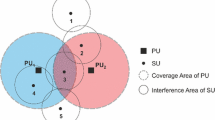Abstract
We propose a novel on-demand minimum interference based routing protocol (MIF) that minimizes the end-to-end delay per data packet for mobile ad hoc networks. MIF does not require periodic exchange of beacons in the neighborhood. During the broadcast of the Route Request (RREQ) messages, each node inserts its identification and location information. The interference index of a link is the number of interfering links surrounding it. Two links are said to interfere with each other, if the distance between the mid points of the two links is within the interference range. The interference index of a path is the sum of interference index values of the constituent links. The destination uses the RREQs to locally construct a weighted graph of the network topology and selects the path with the minimum interference index value. In addition to end-to-end delay, MIF provides higher route stability and packet delivery and lower energy consumption.
Access this chapter
Tax calculation will be finalised at checkout
Purchases are for personal use only
Preview
Unable to display preview. Download preview PDF.
Similar content being viewed by others
References
Jain, K., Padhye, J., Padmanabhan, V., Qiu, L.: Impact of Interference on Multi-hop Wireless Network Performance. In: 9th International Conference on Mobile Computing and Networking, pp. 66–80. ACM, San Diego (2003)
Cormen, T.H., Leiserson, C.E., Rivest, R.L., Stein, C.: Introduction to Algorithms, 2nd edn. MIT Press/ McGraw Hill, New York (2001)
Hassanein, H., Zhou, A.: Routing with Load Balancing in Wireless Ad hoc Networks. In: The 4th International Workshop on Modeling, Analysis and Simulation of Wireless and Mobile Systems, pp. 89–96. ACM, Rome (2001)
Johnson, D.B., Maltz, D.A., Broch, J.: DSR: The Dynamic Source Routing Protocol for Multi-hop Wireless Ad hoc Networks. In: Perkins, C.E. (ed.) Ad hoc Networking, pp. 139–172. Addison-Wesley, New York (2001)
Perkins, C.E., Royer, E.M.: The Ad hoc On-demand Distance Vector Protocol. In: Perkins, C.E. (ed.) Ad hoc Networking, pp. 173–219. Addison-Wesley, New York (2000)
Fall, K., Varadhan, K.: NS-2 Notes and Documentation, The VINT Project at LBL, Xerox PARC, UCB, and USC/ISI (2001)
Bianchi, G.: Performance Analysis of the IEEE 802.11 Distributed Coordination Function. IEEE Journal of Selected Areas in Communication 18(3), 535–547 (2000)
Kim, D., Garcia-Luna-Aceves, J.J., Obraczka, K., Cano, J.-C., Manzoni, P.: Routing Mechanisms for Mobile Ad hoc Networks based on the Energy Drain Rate. IEEE Transactions on Mobile Computing 2(2), 161–173 (2003)
Feeney, L.M.: An Energy Consumption Model for Performance Analysis of Routing Protocols for Mobile Ad hoc Networks. Journal of Mobile Networks and Applications 3(6), 239–249 (2001)
Bettstetter, C., Hartenstein, H., Perez-Costa, X.: Stochastic Properties of the Random-Way Point Mobility Model. Wireless Networks 10(5), 555–567 (2004)
Author information
Authors and Affiliations
Editor information
Editors and Affiliations
Rights and permissions
Copyright information
© 2009 Springer-Verlag Berlin Heidelberg
About this paper
Cite this paper
Meghanathan, N., Sugumar, M. (2009). A Beaconless Minimum Interference Based Routing Protocol for Mobile Ad Hoc Networks. In: Ranka, S., et al. Contemporary Computing. IC3 2009. Communications in Computer and Information Science, vol 40. Springer, Berlin, Heidelberg. https://doi.org/10.1007/978-3-642-03547-0_7
Download citation
DOI: https://doi.org/10.1007/978-3-642-03547-0_7
Publisher Name: Springer, Berlin, Heidelberg
Print ISBN: 978-3-642-03546-3
Online ISBN: 978-3-642-03547-0
eBook Packages: Computer ScienceComputer Science (R0)




